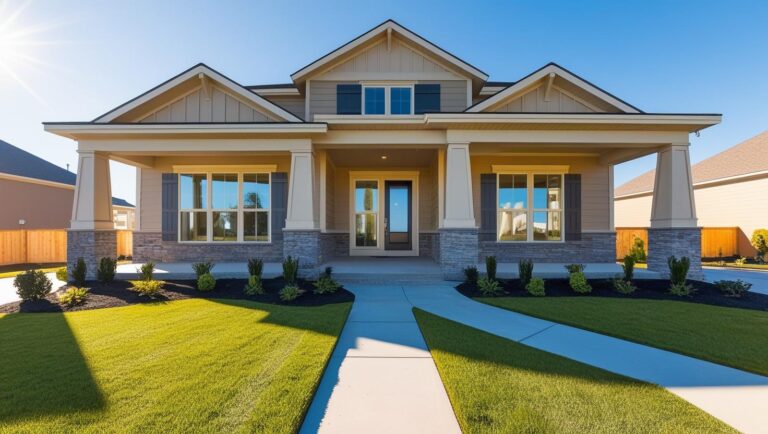Lafayette, Indiana, is a city nestled in Tippecanoe County, well-known for its steady and positive population growth trends.
As of 2024, Lafayette has reached a population of 71,372, demonstrating an annual growth rate of 0.22% according to World Population Review.
Projected trends indicate that the population will continue to increase, largely influenced by favorable economic conditions and demographic factors.
The surrounding metropolitan statistical area (MSA) is also experiencing population dynamics worthy of attention. Population growth, though modest, is expected to persist, showcasing Lafayette’s allure as a vibrant community.
The Federal Reserve’s expected policy of reducing interest rates in 2025 could potentially enhance economic opportunities in the area, making it an attractive destination for businesses and new residents.
Table of Contents
ToggleKey Takeaways:
- Lafayette’s population reached 71,372 in 2024, growing at a steady rate of 0.22% annually.
- High school graduation rates are strong across all age groups, with 44.6% of individuals aged 25-34 holding a bachelor’s degree or higher.
- The median sale price increased by 9.3% year-over-year to $220,000, while homes sell quickly within 14 days.
- Employment steadily rose, with the unemployment rate declining from 4.6% in June to 3.6% in October 2024.
- Reported crimes increased by 4.08%, with extortion (+350%) and drug offenses (+57.6%) seeing significant spikes, while motor vehicle theft declined by 31.9%.
- Median household income is $52,946, with 17.1% of residents living below the poverty line, highlighting economic challenges.
Population Pyramid
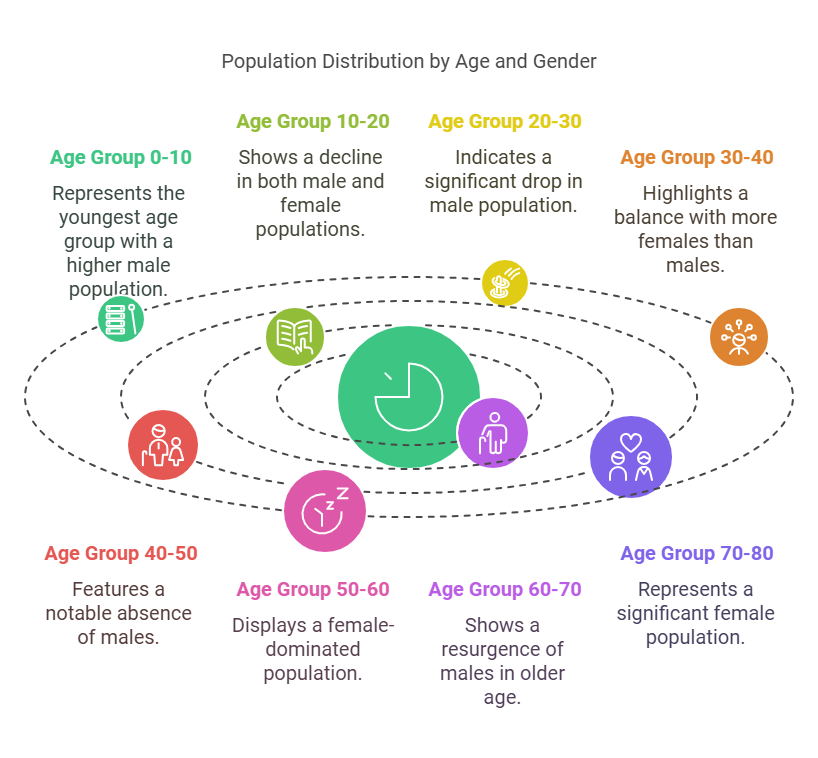
Age Group (Years)
Male Population
Female Population
0-10
4,500
4,000
10-20
3,500
3,000
20-30
2,500
2,000
30-40
1,500
1,000
40-50
500
0
50-60
0
500
60-70
1,000
1,500
70-80
2,000
2,500
80+
3,000
3,500
However, the female population becomes notably higher in older age groups (60+), likely due to longer life expectancy among women as noted by World Population Review.
This shift suggests increasing healthcare and social service needs for elderly females in the area.
Median Age
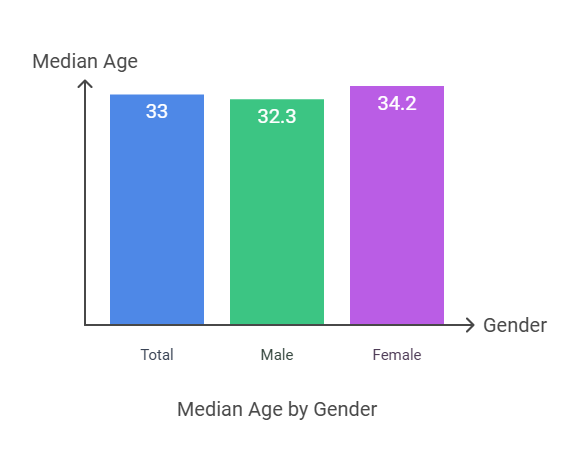
Category
Median Age
Total
33
Male
32.3
Female
34.2
The median age in Lafayette highlights a relatively young population, with females having a slightly higher median age than males.
This suggests that Lafayette’s demographic includes a significant number of working-age adults, contributing to a robust labor force.
Adult and Senior Population
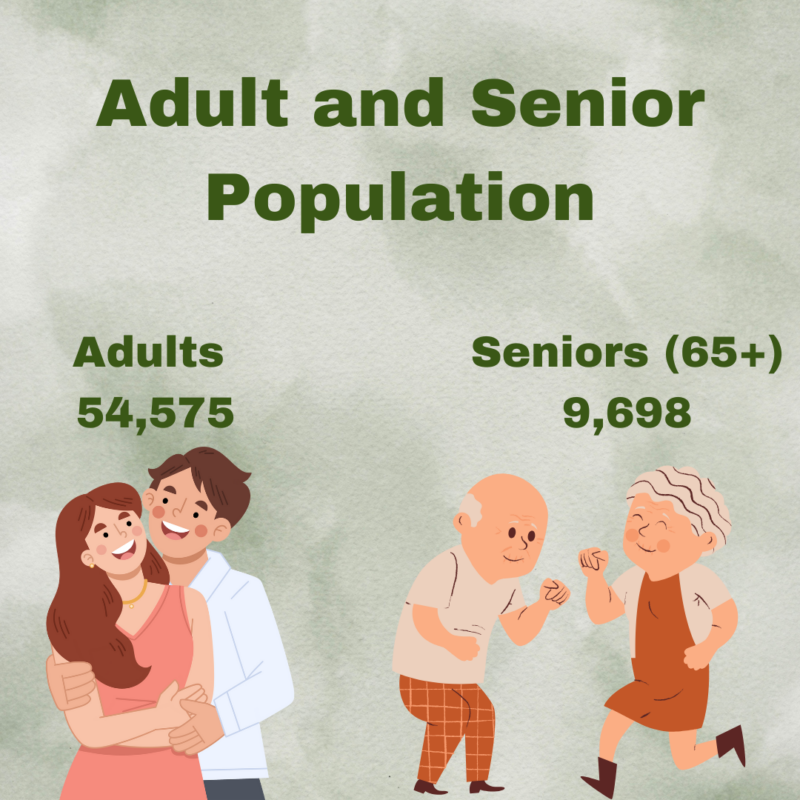
Category
Total Count
Adults
54,575
Seniors (65+)
9,698
This underscores the importance of senior-friendly policies, healthcare services, and retirement community support to accommodate this substantial demographic.
Age Dependency Ratios
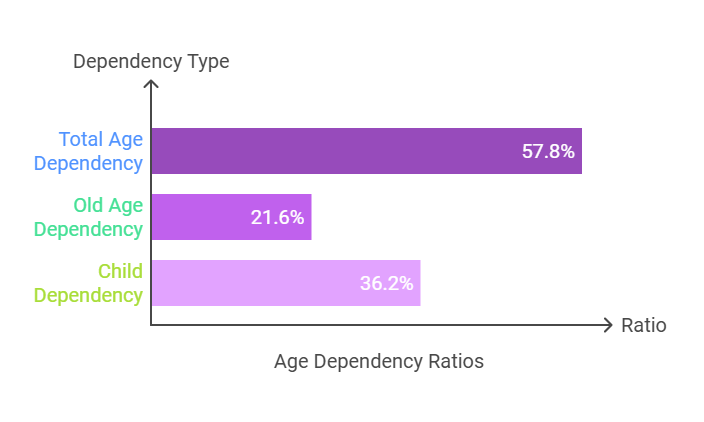
Dependency Type
Ratio (%)
Total Age Dependency
57.8
Old Age Dependency
21.6
Child Dependency
36.2
While old age dependency is comparatively lower, the combined ratio highlights a significant burden on the workforce to support non-working groups.
Sex Ratio
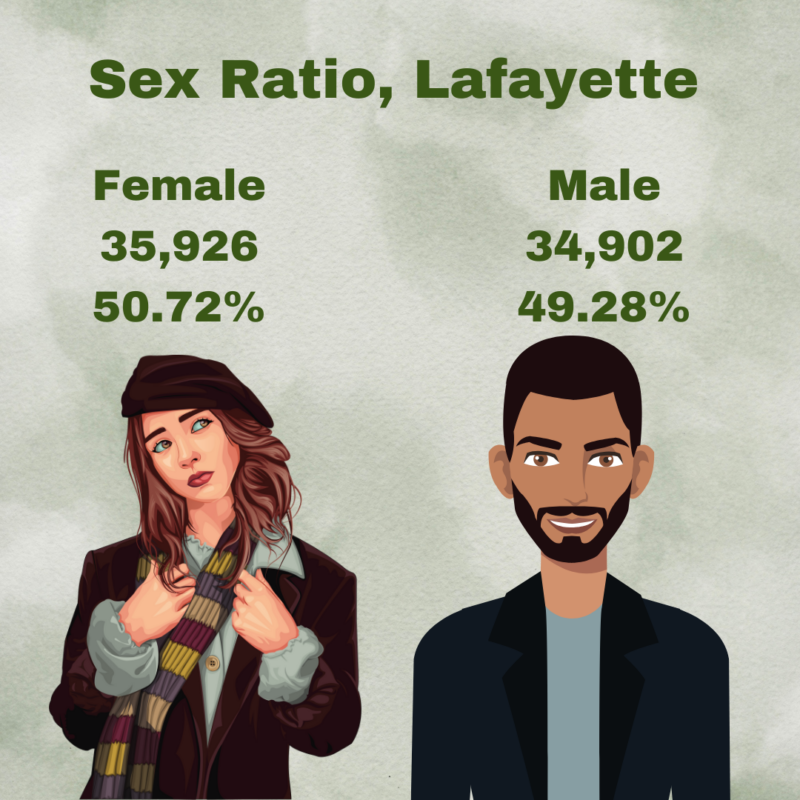
Gender
Population
Percentage
Female
35,926
50.72%
Male
34,902
49.28%
This distribution is typical and suggests no significant gender imbalance that might affect social dynamics or resource allocation.
Racial Composition by Percentage
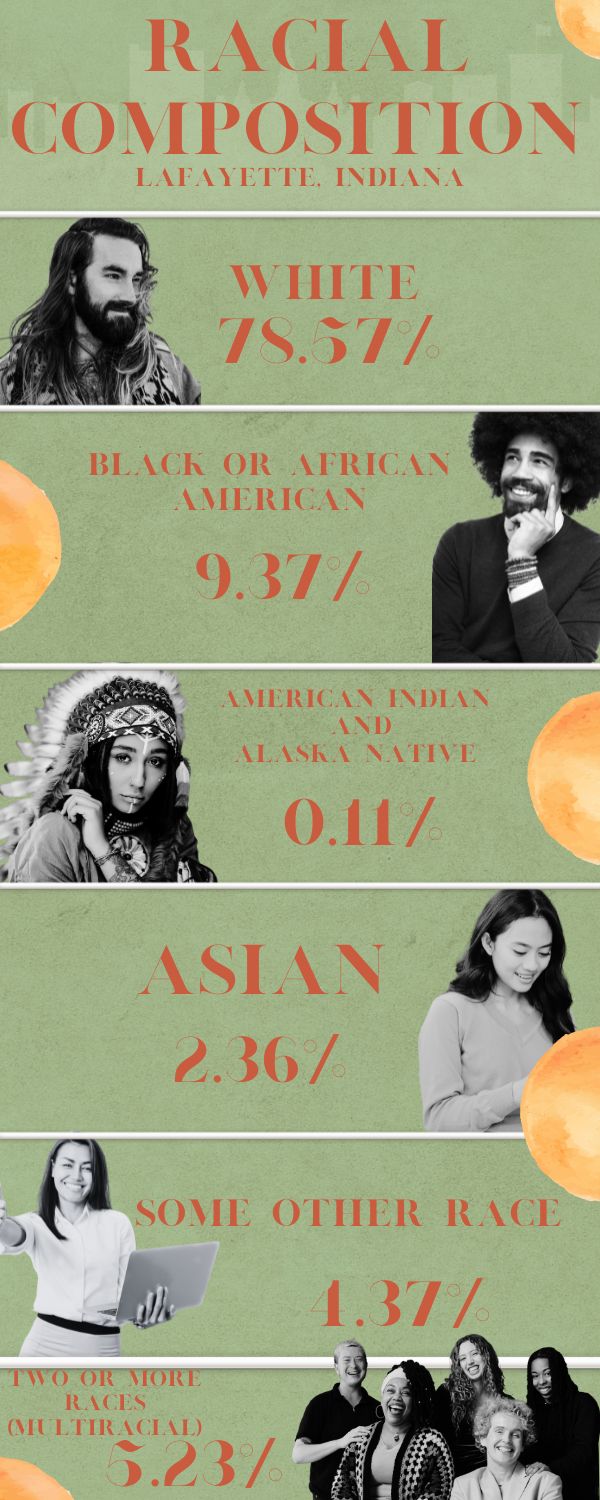
Race
Percentage of Total Population
White
78.57%
Black or African American
9.37%
American Indian and Alaska Native
0.11%
Asian
2.36%
Native Hawaiian and Other Pacific Islander
–
Some other race
4.37%
Two or more races (multiracial)
5.23%
- The overwhelming majority (78.57%) of Lafayette’s population identifies as White as per Neilsbergs research.
- The second-largest racial group is Black or African American, comprising 9.37% of the population.
- Other groups, including multiracial individuals (5.23%) and those identifying as “Some other race” (4.37%), make up smaller portions of the population.
- Representation of Asian individuals is 2.36%, while Native American and Alaska Native individuals constitute a mere 0.11%.
- No representation is recorded for Native Hawaiian and Other Pacific Islander groups.
Income and Poverty
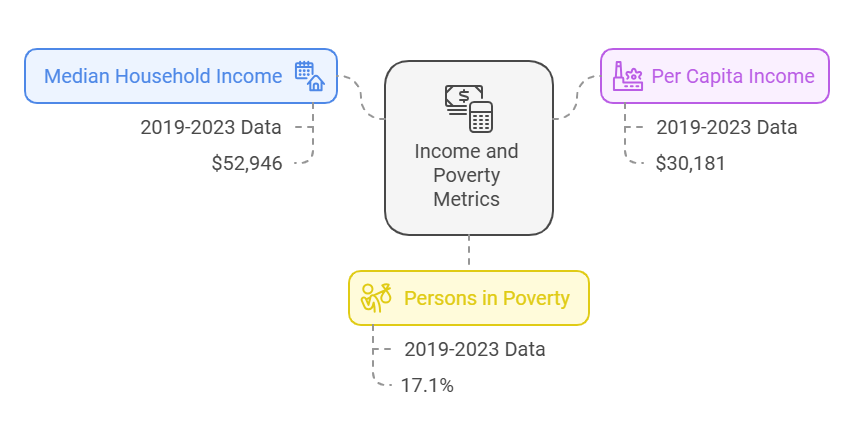
Metric
Value
Median Household Income (2019-2023)
$52,946
Per Capita Income (2019-2023)
$30,181
Persons in Poverty (Percentage)
17.1%
Lafayette’s median household income of $52,946 falls within a moderate range but may indicate economic challenges for some residents compared to national averages. This median suggests a need for tailored economic development initiatives to uplift lower-income households according to census.gov
While reasonable, this figure further highlights economic disparities when considered alongside the poverty rate.
A poverty rate of 17.1% suggests that nearly one in six residents lives below the poverty line. This rate is higher than the national average, underscoring the importance of poverty alleviation programs, affordable housing initiatives, and access to education and job training.
Labor Force Data: Lafayette-West Lafayette, IN (June 2024 – November 2024)
Month
Civilian Labor Force (in Thousands)
Employment (in Thousands)
Unemployment (in Thousands)
Unemployment Rate (%)
June 2024
111.6
106.5
5.1
4.6
July 2024
113.1
107.5
5.6
5.0
August 2024
112.5
107.9
4.7
4.2
September 2024
117.3
112.9
4.4
3.7
October 2024
(p)118.3
(p)114.1
(p)4.2
(p)3.6
The labor force steadily increased over the five months, peaking in October 2024 at 118.3 thousand.
Employment followed a similar upward trend, reaching 114.1 thousand in October 2024.
BLS notes that Unemployment numbers declined consistently, falling from 5.1 thousand in June 2024 to 4.2 thousand in October 2024.
Educational Attainment

Population 25 to 34 Years
- High School Graduate or Higher: 88.9% (10,374 individuals)
- Bachelor’s Degree or Higher: 44.6% (5,206 individuals)
Population 35 to 44 Years
- High School Graduate or Higher: 84.4% (7,299 individuals)
- Bachelor’s Degree or Higher: 19.9% (1,716 individuals)
Population 45 to 64 Years
- High School Graduate or Higher: 84.2% (12,169 individuals)
- Bachelor’s Degree or Higher: 21.6% (3,129 individuals)
Population 65 Years and Over
- High School Graduate or Higher: 93.1% (8,604 individuals)
- Bachelor’s Degree or Higher: 28.6% (2,642 individuals)
Educational attainment in Lafayette shows high percentages of high school graduates across all age groups, with younger groups (25-34) having a significantly higher rate of bachelor’s degrees compared to older populations.
Lafayette Housing Market
Metric
Value
Change Year-Over-Year
Median Sale Price
$220,000
+9.3%
Median Price per Square Foot
$162
+14.4%
Number of Homes Sold
50
-19.4%
Median Days on Market
14
+2 days
Redfin notes that Lafayette’s housing market remains very competitive, with a 9.3% increase in the median sale price and a notable 14.4% rise in the median price per square foot compared to the previous year.
However, the number of homes sold decreased by 19.4%, indicating fewer transactions.
The slight increase in days on the market (from 12 to 14) suggests homes are taking marginally longer to sell, though the market is still fast-paced.
Competitiveness of Lafayette Housing Market
Metric
Value
Change Year-Over-Year
Sale-to-List Price Ratio
97.1%
-0.24 pts
Homes Sold Above List Price
16.0%
-9.81 pts
Median Time to Go Pending
10 days
Unchanged
The market competitiveness is reflected in the high sale-to-list price ratio of 97.1%, though slightly lower than last year. Only 16% of homes sold above the list price, a significant drop compared to the previous year, suggesting buyers have slightly more leverage.
Crime Rate,Lafayette, IN
Crime Type
2024 Cases
2023 Cases
% Change
Animal Cruelty
32
23
+39.1%
Arson
1
0
+100.0%
Assault
194
171
+13.5%
Bribery
0
1
-100.0%
Burglary
73
55
+32.7%
Counterfeit/Forgery
14
5
+180.0%
Destruction of Property
214
183
+16.9%
Drug Offenses
52
33
+57.6%
Embezzlement
4
6
-33.3%
Extortion
18
4
+350.0%
Fraud
95
106
-10.4%
Identity Theft
31
27
+14.8%
Motor Vehicle Theft
32
47
-31.9%
Forcible Sex Offenses
14
18
-22.2%
Stolen Property (Possession)
9
18
-50.0%
Weapon Law Violations
10
5
+100.0%
Total
1,098
1,055
+4.08%
Notable trends include:
- Significant Increases:
- Extortion saw the largest spike (+350%), highlighting a concerning rise in coercive crimes.
- Counterfeit/Forgery increased by 180%, pointing to financial and regulatory vulnerabilities.
- Drug Offenses rose by 57.6%, suggesting a potential uptick in substance-related issues and enforcement.
- Decreases:
- Stolen Property Possession (-50%) and Motor Vehicle Theft (-31.9%) both showed encouraging declines, reflecting improved theft prevention or law enforcement efforts.
- Forcible Sex Offenses decreased by 22.2%, indicating potential progress in prevention measures.
- Consistent Trends:
- Homicide, Human Trafficking, and Prostitution cases remained at zero, reflecting stable reporting in these areas.
- Community Concerns:
- Rising cases in Assault (+13.5%) and Weapon Law Violations (+100%) emphasize the need for community safety initiatives.
- The increase in Burglary (+32.7%) and Destruction of Property (+16.9%) highlights property protection as a priority.
Methodology
- Information was sourced from reliable platforms like World Population Review, census.gov, Redfin, and crime reports from local authorities.
- Trends were identified by comparing year-over-year changes in population, housing, labor, crime, and income data.
- Age, gender, and educational attainment data were analyzed to understand the city’s population composition.
- Income and poverty levels were assessed alongside labor market trends to provide economic context.
- Market data, such as sale prices and competitiveness, were evaluated to highlight real estate trends.
- Key findings were organized into tables and narratives for clarity, ensuring accessibility and relevance for the audience.
Related Posts:
- Indiana Car Accident Statistics 2025: Key Statistics…
- Indiana Lung Cancer Statistics 2025: Key Data and Trends
- Gary, Indiana Population in 2025 - Latest Census…
- Lafayette, Indiana Crime Rate 2025 - What You Need to Know
- Top 15 Reasons to Visit Lafayette, Indiana in 2025
- Indiana Population 2025 - Trends and Growth







